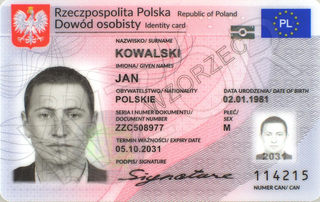
Authentication is the act of proving an assertion, such as the identity of a computer system user. In contrast with identification, the act of indicating a person or thing's identity, authentication is the process of verifying that identity. It might involve validating personal identity documents, verifying the authenticity of a website with a digital certificate, determining the age of an artifact by carbon dating, or ensuring that a product or document is not counterfeit.

A digital signature is a mathematical scheme for verifying the authenticity of digital messages or documents. A valid digital signature on a message gives a recipient confidence that the message came from a sender known to the recipient.
An identity document is any document that may be used to prove a person's identity. If issued in a small, standard credit card size form, it is usually called an identity card, or passport card. Some countries issue formal identity documents, as national identification cards that may be compulsory or non-compulsory, while others may require identity verification using regional identification or informal documents. When the identity document incorporates a person's photograph, it may be called photo ID.

An electronic identification ("eID") is a digital solution for proof of identity of citizens or organizations. They can be used to view to access benefits or services provided by government authorities, banks or other companies, for mobile payments, etc. Apart from online authentication and login, many electronic identity services also give users the option to sign electronic documents with a digital signature.
Electronic authentication is the process of establishing confidence in user identities electronically presented to an information system. Digital authentication, or e-authentication, may be used synonymously when referring to the authentication process that confirms or certifies a person's identity and works. When used in conjunction with an electronic signature, it can provide evidence of whether data received has been tampered with after being signed by its original sender. Electronic authentication can reduce the risk of fraud and identity theft by verifying that a person is who they say they are when performing transactions online.

Mexican passport is the passport issued to Mexican citizens for the purpose of travelling abroad. The Mexican passport is also an official ID and proof of Mexican citizenship. According to the November 2023 Henley Visa Restrictions Index, holders of a Mexican passport can visit 160 countries without a visa, placing Mexico in the 22nd rank in terms of global travel freedom.

The Colombian passport is a travel document which is issued to citizens of Colombia for the purpose of international travel. Since September 2015, a biometric passport has been issued, but the previously issued machine-readable passport can be used through its expiration date.
There are several identity documents used in Sweden. None are compulsory by law, meaning that there is no formal penalty for not possessing one. Certified identification cards are issued by the tax agency. The Swedish police issues passports and national identity cards for Swedish citizens. A Swedish driver's license, issued by the transport agency, is also accepted as an identity document. Banks sometimes issue identity cards for established customers or their children.

Entrust Corp., formerly Entrust Datacard, provides software and hardware used to issue financial cards, e-passport production, user authentication for those looking to access secure networks or conduct financial transactions, trust certificated for websites, mobile credentials, and connected devices. The privately-held company is based in Shakopee, Minnesota and employs more than 2,500 people globally.

Every Polish citizen 18 years of age or older residing permanently in Poland is required to have an identity card issued by the local office of civic affairs. Children as well as Polish citizens living permanently abroad are entitled, but not required, to have one. Identity cards are valid for a period of 10 years.

The Moldovan identity card is a compulsory identity document issued in the Republic of Moldova. Every Moldovan citizen who resides in the Republic of Moldova must have an ID card. Moldovan ID cards are issued by the Public Services Agency. The following are required to have an ID card: from birth until 10 years of age, from 10 years of age until 16, from 16 years of age until 25, and from 25 years of age until 45. After 45 years of age, the ID card is not required to be renewed.

The Biometric Database Law is an Israeli law which the Knesset passed in December 2009, determining that fingerprints and facial contours would be collected from all Israeli residents, that the collected data would be integrated onto the Israeli digital identity cards and digital passports, and that a biometric government database of all Israeli citizens and residents would be created which would be used for biometric identification that would allow the management of access control, identification of individuals and assist in locating individuals suspected of criminal activity by the law enforcement officials. When the law passed in December 2009 it was determined that the law be gradually applied and that at the first phase, the inclusion of one's biometric data in the central database would be voluntary.

The German Identity Card is issued to German citizens by local registration offices in Germany and diplomatic missions abroad, while they are produced at the Bundesdruckerei in Berlin.

The Greek identity card is the official national identification document for Greek citizens. It is issued by the Hellenic Police.

The Ghana Card is the national Identity card that is issued by the Ghanaian authorities to Ghanaian citizens – both resident and non-resident, legal and permanent residents of foreign nationals. It is proof of identity, citizenship and residence of the holder. The current version is in ID1 format and biometric. It is issued by the National Identification Authority of Ghana and Regarded as a property of the country as such. In July 2023, through the initiative of the Vice President, Dr. Mahamudu Bawumia, new card numbers were issued to newborn babies as part of pilot program to incorporate newborn babies unto the database.
The Lebanese identity card is a compulsory Identity document issued to citizens of the Republic of Lebanon by the police on behalf of the Lebanese Ministry of Interior or in Lebanese embassies/consulates (abroad) free of charge. It is proof of identity, citizenship and residence of the Lebanese citizens.
Biometrics refers to the automated recognition of individuals based on their biological and behavioral characteristics, not to be confused with statistical biometrics; which is used to analyse data in the biological sciences. Biometrics for the purposes of identification may involve DNA matching, facial recognition, fingerprints, retina and iris scanning, voice analysis, handwriting, gait, and even body odor.

The Norwegian identity card, commonly referred to as the national identity card in Norway, is a non-compulsory biometric identity document issued since 30 November 2020. It is one of two official identity documents issued by the Norwegian Police Service, the other being the Norwegian passport. It is only issued to Norwegian citizens, and may indicate citizenship so that it can be used as a travel document facilitating freedom of movement within the European Free Trade Association and the European Economic Area. For travel within the Nordic countries no identity documentation is legally required for Nordic citizens due to the Nordic Passport Union.

The Icelandic identity card, is an identity document issued by Registers Iceland since 12 April 1965. It is one of three official identity documents issued by the Icelandic Government, along with the Icelandic passport and Icelandic driving license. It is voluntarily issued to residents aged over 14. It is valid in the Nordic countries as travel and identification documentation. Due to its lack of security features it cannot currently be used as a travel document to other countries in the EU/EEA. Identity documents are not compulsory in Iceland. An electronic ID is issued separately to the regular ID card.

The identification document of Uruguay, formerly known as "Cédula de identidad". is issued by the Ministry of the Interior and the
















